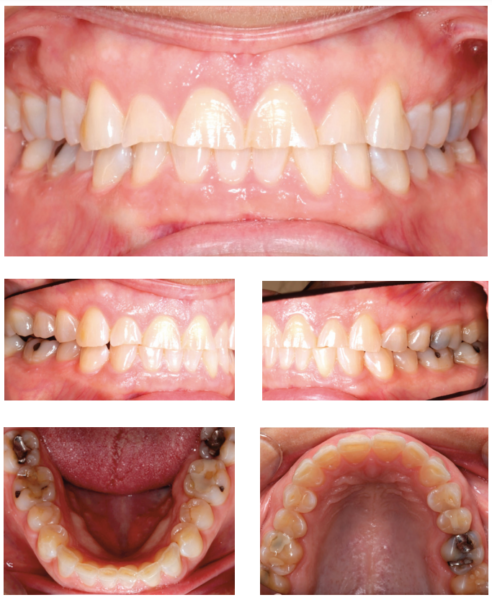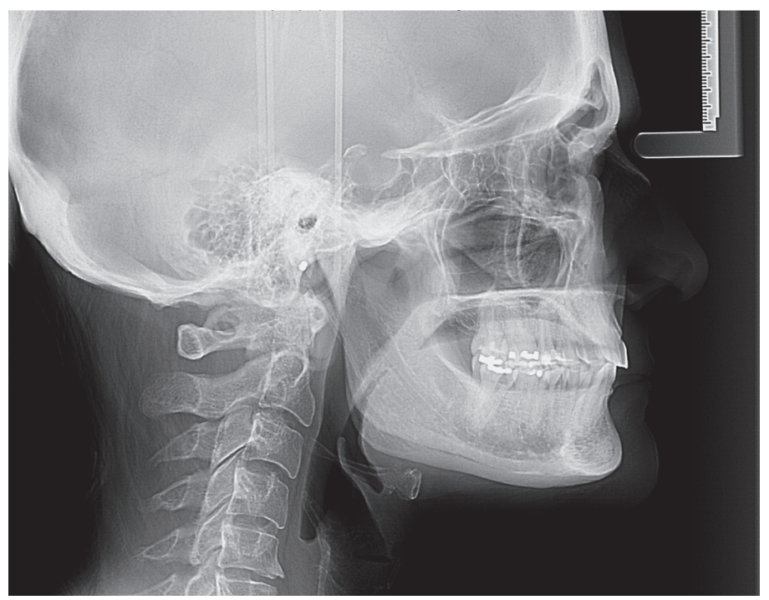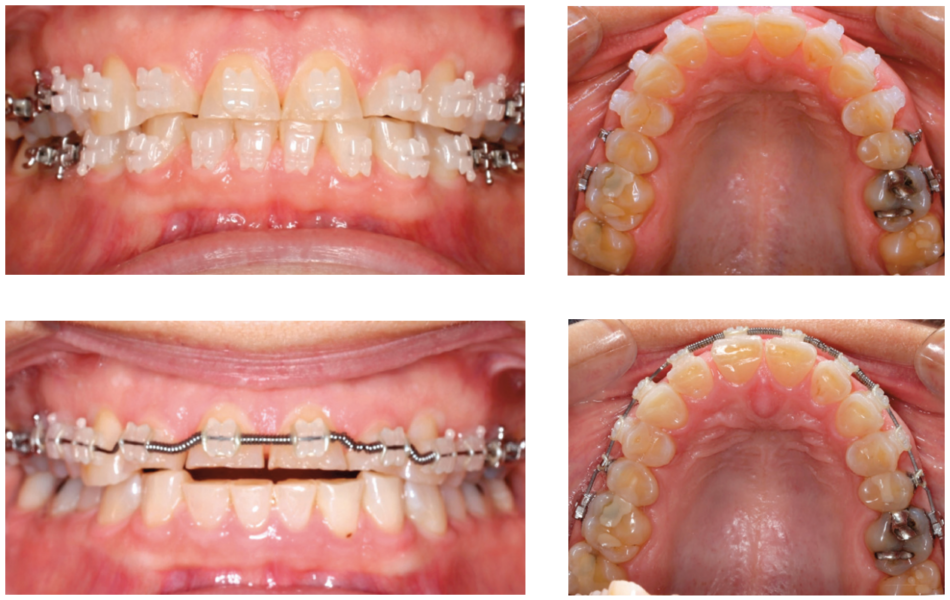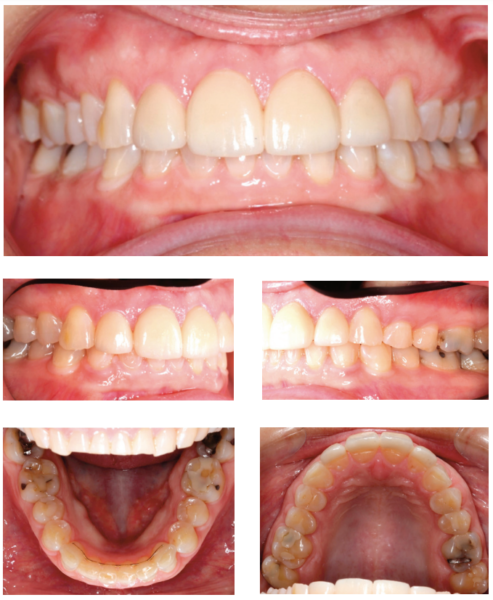Dr. Jane Wright chose Symetri™ Clear brackets by Ormco to treat this patient’s clinical and esthetic issues.
Dr. Jane Wright illustrates the clinical and esthetic concerns that drove the treatment plan for this patient
Growing up in the orthodontic world, I have had a front-row view of our industry and watched the evolution of bracket styles, patient requests, and product innovation. In this exciting, ever-changing field, we help people achieve a beautiful smile. It’s important and life-changing.
Through this unique perspective on the orthodontic industry, I have gained awareness of teeth straightening modalities, companies, and brands that my orthodontist father tried over the years, including what worked and what hasn’t for his patients. His curiosity and love of helping people create functional, beautiful smiles inspired me to become an orthodontist and eventually work with him in our practice.
In our two practices in Kenosha and Salem, Wisconsin, we work with children and adults with mild-to-complex malocclusions. For our adult patients seeking orthodontic treatment, I typically use esthetically pleasing clear braces or clear aligners to help resolve crowding and improve dental function. Patients with complex alignment and restorative needs often have more efficient treatment times with fixed appliances.1 In these cases, I prefer Ormco’s Symetri™ Clear brackets. Likewise, not all patients want the responsibility of remembering to wear clear aligners and sometimes prefer bonded orthodontic braces to accommodate their busy lives.
It is helpful to have an esthetic bracket to offer adult patients when doing multi-directional, pre-restorative tooth movements. Symetri Clear brackets are advanced esthetic brackets designed for refined strength, patient comfort, and easy/safe debonding and repositioning without fracturing. Its proprietary base design and patented debonding plier enable safe, easy, and non-destructive bracket removal in one piece with minimal force. It’s comprised of a combination of proprietary ceramic particles (polycrystalline alumina) that create a clear, esthetic appearance while meeting clinical demands. Patients like that they are resistant to staining and designed to blend well with multiple shades of enamel.2
The following is one of our adult orthodontic cases treated with Ormco’s Symetri brackets.

Case report
A 49-year-old female presented for an initial orthodontic exam with the chief complaint of bruxing and excessive wear on her teeth, especially the anterior. She was aware of the loss of tooth height and discussed restoration plans with her dentist. She had no history of previous orthodontic treatment and was wearing a maxillary flat-plane occlusal guard from her dentist. She was aware of daytime clenching and grinding but did not report any TMJ pain, clicking, or popping. Maximum opening and range of motion were within normal limits. Cephalometric analysis showed that she had a brachycephalic skeletal pattern, but ANB and inter-incisal angles were normal. Occlusal wear in and of itself does not affect patient quality of life,3 but some patients are self-conscious about the appearance of their short, worn teeth, which is the category that this patient fits into. Her chief concern was to improve her dental esthetics.
The patient reported chronic life stress and was unaware that her teeth were not supposed to be in constant contact during the day. We discussed self-care management of the TMJs, practicing lip seal and nasal breathing while keeping the teeth separated and masseters relaxed.4 It was discussed that if she chose to pursue orthodontic treatment, she would have to discontinue her maxillary night splint until orthodontic treatment concluded, which she accepted. We discussed fabricating a new maxillary flat-plane splint after her restorative work was complete.
With the anterior tooth wear, she had lost a few millimeters from the incisal edges of her teeth, which had super-erupted to maintain contact with the lower anterior teeth. The patient had a gingival height discrepancy with teeth Nos. 6-11 due to the wear and subsequent super-eruption. She had also lost tooth structure from the incisal edges on teeth Nos. 23-26 but did not want to restore the lower anterior teeth post-orthodontic treatment. Her general dentist planned on restoring teeth Nos. 7, 8, 9, and 10 with veneers or crowns.

Treatment plan
The orthodontic treatment plan was to bond upper and lower Ormco Symetri brackets (bidimensional prescription) and intrude teeth Nos. 7-10 along with lower anterior (teeth Nos. 23-26) to establish better overbite and overjet for restorative work. Due to the loss of height of her anterior teeth, the interproximal contacts had also moved gingivally, which decreased the width of the anterior teeth (height-to-width ratios were off). In order to establish better crown ratios, the plan was to open space mesial and distal to teeth Nos. 7-10 with open coil springs.
Though she had a rather deep bite, the Ormco Symetri bracket was low-profile and petite enough to bond the entire upper and lower braces the same day. She had no occlusal interferences with the brackets, and bite turbos were not required. The Symetri bracket’s rounded contours were comfortable to the patient, and she liked that the brackets blended with her tooth shade and met her esthetic requirements. She reported adjusting to the braces easily. The initial wires were light, 0.014 nickel-titanium archwires, and we gradually progressed into rectangular, 0.16 x 0.22 stainless steel wires for finishing. Coils were added mesial and distal to teeth Nos. 7-10 to improve the width-to-length ratios of the crowns, and teeth Nos. 7-10 were stepped up gradually to intrude them. Ideally, gingival margins of teeth Nos. 8 and 9 should be at the level of tooth No. 6 and 11, while teeth Nos. 7 and 10 should be about 1.5 mm lower5 than the centrals. As the maxillary anterior teeth were intruded, and spaces were introduced mesial and distal, the incisal angulation of the teeth also increased. This can be protective for people with a history of bruxing, in addition to leaving more inter-incisal clearance for the restoring dentist.
Despite her history of bruxing, she never broke a bracket. During treatment, power-chain, coils, and rectangular stainless-steel wires were used, and the Symetri brackets withstood all the forces and attachments applied to them by this patient. There were a few occasions where the patient’s wire was broken from her heavy occlusal forces and bruxing, but the brackets did not debond from her clenching. She worked on her “self-care” of the TMJs, decreasing her stress and increasing her awareness of tooth touching during the day.

Debonding Symetri Clear brackets
Repositioning brackets, in this case, was unnecessary, but if they had been, the Ormco Symetri bracket debonds easily without any bracket deformation or breakage. The same bracket can be re-bonded,6 which is more economical than other clear bracket systems that fracture or fold while debonding and repositioning.
On the day of debonding, the patient presented with a broken wire distal to tooth No. 10 from heavy occlusal forces. Tooth No. 10 had moved lingual and was in contact with tooth No. 23, so only the lower arch was debonded. The lower anterior teeth were retained with a gold-plated stainless steel 0.020 twist wire bonded to the lingual of teeth Nos. 22-27. A new 0.16 x 0.22 TMA wire was fabricated with an additional open-coil spring distal to tooth No.10. After four weeks, tooth No. 10 was out of contact, and her upper arch was debonded.

I have found debonding Ormco Symetri bracket is similar, if not easier, than debonding stainless steel brackets. The archwires and a-ties can stay on, and the custom Symetri Clear deboning plier quickly clicks off each bracket in one piece with no bracket breakage or folding. There is no torquing, twisting, or pulling to remove the Ormco Symetri bracket, which makes the debond very comfortable and low-stress for both patients and practitioners. Adhesive clean-up from the enamel was carried out with a green rubber wheel.
After the patient was debonded in the maxillary arch, an upper Essix retainer was fabricated and delivered the same day. She was instructed to wear it at least 12 hours/day or night to maintain the position of tooth Nos. 7-10 and their respective spacing.

Gingival health was excellent, and her dentist was ready to move forward with veneers on teeth Nos. 7, 8, 9, and 10 shortly after that. A new maxillary Essix was fabricated when she had her temporary veneers, and a final maxillary clear Essix was delivered once her restorations were complete. She was instructed to wear the upper clear retainer to bed at night, and she will also be fit for a new maxillary flat-plane splint if her clenching and grinding continue. The patient’s awareness of her bruxing improved throughout treatment, and she has reduced her daytime clenching.
This case was completed in 14 months and likely would have been completed sooner if not for her occasional broken archwires. She was delighted with the esthetics and comfort of her clear brackets and is happy with her esthetic result. The Ormco Symetri Clear bracket system helps to increase case acceptance while giving the orthodontist the control and predictability required to finish complex restorative cases efficiently.
Dr. Mark N. Coreil offered his opinion on the clinical benefits of Symetri Clear brackets by Ormco in his practice. https://orthopracticeus.com/orthodontic-concepts/symetri-clears-esthetic-and-clinical-benefits/
- Murphy SJ, Lee S, Scharm JC, Kim S, Amin AA, Wu TH, Lu WE, Ni A, Ko CC, Fields HW, Deguchi T. Comparison of maxillary anterior tooth movement between Invisalign and fixed appliances. Am J Orthod Dentofacial Orthop. 2023 Jul;164(1):24-33.
- Data on file at Ormco.
- Kanaan M, Brabant A, Eckert GJ, Hara AT, Carvalho JC. Tooth wear and oral-health-related quality of life in dentate adults. J Dent. 2022 Oct;125:104269.
- Proffit WR, Fields HW, Sarver DM. Contemporary Orthodontics. 4th ed. St Louis, MO: Mosby Elsevier;2007:656-657.
- Proffit WR, Fields HW, Sarver DM. Contemporary Orthodontics. 4th ed. St Louis, MO: Mosby Elsevier;2007:190-191.
- Debonded and repositioned/rebonded on the same tooth one time (1x) using Ortho Solo™ Primer and Blugloo™ Adhesive per IFU 070-2244, Rev F. Data on file with Ormco.
Stay Relevant With Orthodontic Practice US
Join our email list for CE courses and webinars, articles and mores

 Jane Wright, DDS, MS, is an ABO-certified orthodontist with a private practice in Kenosha, Wisconsin, and adjunct clinical faculty at Maquette University School of Dentistry in the Orthodontic Department. Dr. Wright earned her BS in Nutrition Science from the University of Minnesota, Twin Cities, and her DDS, MS, and Orthodontic Certificate from Marquette University. She is on the College of Diplomates of the American Board of Orthodontics Council.
Jane Wright, DDS, MS, is an ABO-certified orthodontist with a private practice in Kenosha, Wisconsin, and adjunct clinical faculty at Maquette University School of Dentistry in the Orthodontic Department. Dr. Wright earned her BS in Nutrition Science from the University of Minnesota, Twin Cities, and her DDS, MS, and Orthodontic Certificate from Marquette University. She is on the College of Diplomates of the American Board of Orthodontics Council.
